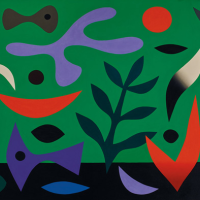13. JOHN COBURN

The major elements in Coburns work are simplicity, order, colour, a concern with elemental subjects and a reduction to their symbolic essentials.1
White Bird c1974 represents a magnificent highpoint in the career of John Coburn, when he firmly established his pre-eminence in the field of Australian abstract art. In 1972, Coburn returned to Sydney from three years in France, having been appointed Head of the National Art School at East Sydney Technical College. The following year, Coburns monumental tapestries, Curtain of the Sun and Curtain of the Moon, were unveiled at the official opening of the Sydney Opera House, to popular and critical acclaim. The Opera House tapestries touted as the second largest ever woven, after Graham Sutherlands tapestry for Coventry Cathedral made Coburn a household name.2 With the greater financial security that this afforded, Coburn left teaching in 1974 and became an artist full-time, establishing a diverse practice of painting, printmaking and tapestry design. Coburns renewed dedication to his art in the 1970s would result in works of unbridled confidence and intensity.
The present work which was privately commissioned in the early 1970s has been held in the same family collection since its creation, and has never before been publicly exhibited. Coburns White Bird is a tour de force of colour, scale, contrast and form. The viewer is immediately struck by its vitality and immersive power. On a canvas spanning over four metres in length, Coburn presents a vibrant frieze of organic shapes, held in perfect harmony. The works extraordinary palette includes some fourteen different colours, from tonal greens and browns to contrasting shades of blue, red and purple. But the most remarkable aspect of White Bird is its visual rightness its undeniable sense of order and equilibrium, despite manifold variations and contrasts of form and colour. How does Coburn achieve this?
The composition of White Bird is anchored by two basic elements: a flat, emerald-green backdrop, and a solid black ground, which is slightly inverted to create an illusion of depth. The significance of this latter element is ambiguous, perhaps deliberately so: what appears at first glance to be the fertile soil of a garden bed could just as easily be an altar or tabletop. In this way, Coburns abstract garden is imbued with a sacramental quality, aligned with pantheistic notions of nature as the embodiment of a divine creator. Coburns placement of the floating organic forms is also deeply considered: three, plant-like shapes in grey-green provide a symmetrical framework for the composition. The eponymous bird on the left is counterbalanced by a bare-branched tree on the right; each highlighted by distorted crescents bearing a black-and-white ombre effect. Tertiary colours are interspersed with bright primary hues; pointed, vertical shapes are offset by their rounded, horizontal counterparts. In generating this rhythmic pattern of complements and contrasts, Coburn attains visual order and harmony. The artists rare aptitude for composition was underlined in a review of his solo exhibition at The Macquarie Galleries in 1973:
No-one else has quite the sense of colour found in a Coburn painting, nor the sense of shape and understanding of balance so necessary to avoid mere decoration. While other artists in late middle-age have hesitated and faltered in mid-career, Coburn seems to go from strength to strength.3
The prevailing colour and style of White Bird bear close resemblance to the celebrated painting, Aubusson Green 1973 (see Figure 2), in the collection of the National Gallery of Australia, Canberra. In these and other major works of the early 1970s such as Valencia 1973 (QAGOMA collection, Brisbane) and Garden in Vevey 1973 (BHP collection) we see a significant departure from Coburns hard-edge paintings of the previous decade, in favour of semi-abstract imagery that is more organic and lyrical in tone. As the title of Aubusson Green would imply, these stylistic developments owed much to Coburns time in France, and in particular his long-held admiration for the latter works of Henri Matisse (1869-1954). One of Coburns most formative experiences as a young artist was his visit to the exhibition French Painting Today, held at the Art Gallery of New South Wales in 1953. This exhibition of 119 paintings and four tapestries included major works by Matisse alongside those of Pablo Picasso (1881-1973), Alfred Manessier (1911-1993), Fernand Lger (1881-1955) and Jean Lurat (1892-1966).4 Coburns gravitation towards shape-based abstraction in the 1950s and 60s as opposed to the linear abstraction that dominated contemporary Australian and American art of the era was profoundly shaped by his affinity with French modernism. The coral- and plant-like shapes in White Bird were undoubtedly prefigured by Matisses famous cut-outs of the 1940s.
A second, but nonetheless significant, source of the imagery in White Bird was Coburns own childhood among the lush rainforests and plantations of northern Queensland. As Alan Rozen observes, the tropical rainforests with their deluge of colours are ever present; gardens, especially tropical gardens, being a favourite and constant theme.5 In this sense, White Bird may be seen as a celebration of natures never-ending capacity for renewal, in parallel with what Nadine Amadio calls the resurrection of the human spirit.6 Five decades on, it is the profound optimism of Coburns art that continues to resonate.
Footnotes:
1. Rozen, A., The Art of John Coburn, Ure Smith, Sydney, 1979, p.12
2. Klepac, L., John Coburn: The Spirit of Colour, The Beagle Press, Sydney, 2003, p.10
3. De Groen, G., Sense of Colour and Balance, The Canberra Times, Canberra, 13 December 1973, p.25
4. Rozen, A., op. cit., p.13
5. Ibid., p.8
6. Amadio, N., John Coburn: Paintings, Craftsman House, Sydney, 1988, p.5
Catherine Baxendale